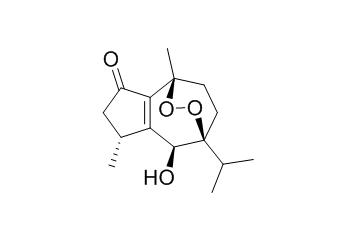Isonardoperoxide
Isonardoperoxide shows strong antimalarial activity against Plasmodium falciparum malaria (6.0 × 10−7 M).
Inquire / Order:
manager@chemfaces.com
Technical Inquiries:
service@chemfaces.com
Tel:
+86-27-84237783
Fax:
+86-27-84254680
Address:
1 Building, No. 83, CheCheng Rd., Wuhan Economic and Technological Development Zone, Wuhan, Hubei 430056, PRC
Providing storage is as stated on the product vial and the vial is kept tightly sealed, the product can be stored for up to
24 months(2-8C).
Wherever possible, you should prepare and use solutions on the same day. However, if you need to make up stock solutions in advance, we recommend that you store the solution as aliquots in tightly sealed vials at -20C. Generally, these will be useable for up to two weeks. Before use, and prior to opening the vial we recommend that you allow your product to equilibrate to room temperature for at least 1 hour.
Need more advice on solubility, usage and handling? Please email to: service@chemfaces.com
The packaging of the product may have turned upside down during transportation, resulting in the natural compounds adhering to the neck or cap of the vial. take the vial out of its packaging and gently shake to let the compounds fall to the bottom of the vial. for liquid products, centrifuge at 200-500 RPM to gather the liquid at the bottom of the vial. try to avoid loss or contamination during handling.
Phytother Res.2022, 10.1002:ptr.7602.
Hum. Ecol. Res.2025, 63(2):165-174
J Basic Clin Physiol Pharmacol.2016, 27(1):1-8
Horticulture Research2023, uhad259
Molecules.2023, 28(13):4972.
Nutrients.2019, 12(1)
Front Mol Neurosci.2023, 15:1083189.
Journal of Food and Drug Analysis2023, 31(3), 9.
BMC Complement Altern Med.2018, 18(1):221
Molecules.2024, 29(23):5632.
Related and Featured Products
Tetrahedron Letters, 1998, 39(11):1361-1364.
Novel antimalarial guaiane-type sesquiterpenoids from Nardostachys chinensis roots.[Reference:
WebLink]
METHODS AND RESULTS:
Three guaiane-type sesquiterpenoids, nardoperoxide (1a), Isonardoperoxide (2a) and nardoxide (3), were isolated from Nardostachys chinensis roots. Their structures were elucidated by spectral means.
CONCLUSIONS:
Among them, two endoperoxides, nardoperoxide (1a) and Isonardoperoxide (2a), showed strong antimalarial activity against Plasmodium falciparum malaria (EC50 1.5 × 10−6 and 6.0 × 10−7 M, respectively).



